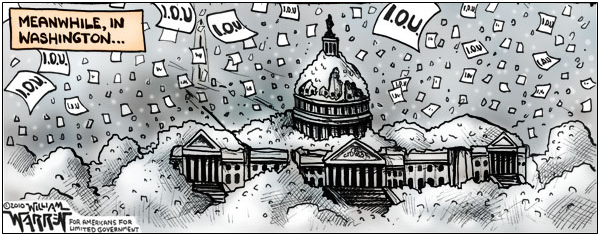U.S. Treasury Secretary Janet Yellen has warned that the U.S. debt ceiling will come due on Jan. 19, as so-called “extraordinary measures” of refinancing the debt up to the current limit $31.4 trillion are reached, setting up a showdown in Congress as the newly elected U.S. House majority led by Republicans looks to trim the federal budget by capping discretionary and mandatory spending in key areas.
The debt ceiling legislation was last increased in Dec. 2021 by $2.5 trillion when Democrats controlled both the House and the Senate.
Now, Republicans have a seat at the table. The last time this happened was in 2011, and the result was discretionary spending caps, known as budget sequestration, that limited the growth of defense and non-defense discretionary spending, saving hundreds of billions of dollars.
As a result, the budget deficit was brought from $1.3 trillion in 2011 all the way down to $441 billion in 2015, the year Republicans won back the U.S. Senate. From there, the practice was terminated, and the budget deficit again ballooned, reaching $983 billion by 2019.
That was before Covid. In 2020, a record $3.1 trillion deficit, according to data compiled by the White House Office of Management and Budget. $2.7 trillion in 2021. $1.4 trillion in 2022.
All told, more than $6 trillion was printed, borrowed and spent into existence to offset the global economic lockdowns that temporarily disabled labor markets’ functionality as citizens were told to remain in their households.
The result was massive inflation which was exacerbated by another black swan, Russia’s invasion of Ukraine that further harmed global supply chain issues already beleaguered by the production halt from Covid.
Now Congress can be a part of the solution. Simply by spending less or even freezing discretionary spending as in the successful 2011 debt ceiling compromise between then U.S. House Speaker John Boehner (R-Ohio) — who had the Tea Party-fueled majority to help create pressure — and former President Barack Obama, the Federal Reserve won’t need to create as many new dollars to offset a borrowing binge.
Especially as the global economy catches up with demand from the Covid production halt, slowing down the printing and borrowing is the way Congress can tap on the brakes and get control on the inflation.
Juicy options for House Republicans to restore fiscal sanity include rolling back green spending from the Inflation Reduction Act and the stepped up Internal Revenue Service enforcement including the additional 87,000 IRS agents put in place by Biden and last year’s Democratic-controlled Congress, as well as creating a years-long plan to reduce the budget deficit to more sane levels.
But to get there might require some defense cuts in order to get the Senate to agree to non-defense cuts. In the least, that’s how it was done last time, which is to say that might be the only way. Already House Speaker McCarthy has said he is open to this possibility, looking to freeze spending at 2022 levels.
And that’s all the original sequestration truly contemplated, holding discretionary spending at more sustainable levels for a few years. If it could be done in 2011, it can be done in 2023. It’s not asking too much from taxpayers’ who have been footing the bill via the inflation tax.
For House Speaker McCarthy, this creates an opportunity for the majority to vote on amendments that can reduce the size and scope of government. There aren’t too many must-pass pieces of legislation, and so this is a very big test for the new House Republican majority to, if only temporarily, to restore fiscal sanity in Washington, D.C. especially before any recession happens to worsen, and the reverse pressure will be to increase spending, especially if unemployment begins rising. If they don’t cut spending now, they might not get a chance later.
Robert Romano is the Vice President of Public Policy at Americans for Limited Government.







